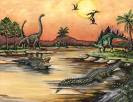Norse mythology
Most of the existing records on Norse mythology date from the 11th to 18th century, having gone through more than two centuries of oral preservation in what was at least officially a Christian society. At this point scholars started recording it, particularly in the Eddas and the Heimskringla by Snorri Sturluson, who believed that pre-Christian deities trace real historical people.
According to Norse myth, the beginning of life was fire and ice, with the existence of only two worlds: Muspelheim and Niflheim. When the warm air of Muspelheim hit the cold ice of Niflheim, the jotunn Ymir and the icy cow Audhumla were created. Ymir's foot bred a son and a man and a woman emerged from his armpits, making Ymir the progenitor of the Jotnar.
The Germanic tribes rarely or never had temples in a modern sense. The Blot, the form of worship practiced by the ancient Germanic and Scandinavian people, resembled that of the Celts and Balts. It occurred either in sacred groves, at home, or at a simple altar of piled stones known as a "horgr."
While a kind of priesthood seems to have existed, it never took on the professional and semi-hereditary character of the Celtic druidical class. This was because the shamanistic tradition was maintained by women, the Volvas. It is often said that the Germanic kingship evolved out of a priestly office.
The Germanic gods have left numerous traces in modern vocabulary and elements of every day western life in most Germanic language speaking countries. An example of this is some of the names of the days of the week: modelled after the names of the days of the week in Latin (named after Mars, Mercury, Jupiter, Venus, and Saturn), the names for Tuesday through to Friday were replaced with Germanic equivalents of the Roman gods and the names for Monday and Sunday after the Sun and Moon. In English, Saturn was not replaced.
Wong joon mien
5generosity
Thursday, July 15, 2010
Subscribe to:
Post Comments (Atom)

No comments:
Post a Comment